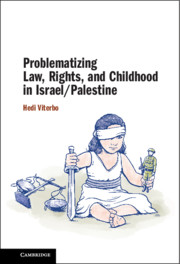Book contents
- Frontmatter
- Contents
- Acknowledgments
- Abbreviations
- 1 Conceptual and Theoretical Foundations
- 2 Casting the First Stone: The Israeli Legal System, Its Human Rights Critics, and Their Approaches to Young Palestinians
- 3 The Age of Governing: Young Age as a Means of Control
- 4 Boundary Governance: Amending Childhood and Separating Palestinians
- 5 Stolen Childhood: Voice, Loss, and Trauma in Human Rights Reports
- 6 Sights of Violence: Childhood in the Visual Battlefield
- 7 Infantilization and Militarism: Soldiers as Children, Children as Soldiers
- 8 Unsettling Children: Israeli Law and Settlers’ Childhood
- Index
6 - Sights of Violence: Childhood in the Visual Battlefield
Published online by Cambridge University Press: 05 August 2021
- Frontmatter
- Contents
- Acknowledgments
- Abbreviations
- 1 Conceptual and Theoretical Foundations
- 2 Casting the First Stone: The Israeli Legal System, Its Human Rights Critics, and Their Approaches to Young Palestinians
- 3 The Age of Governing: Young Age as a Means of Control
- 4 Boundary Governance: Amending Childhood and Separating Palestinians
- 5 Stolen Childhood: Voice, Loss, and Trauma in Human Rights Reports
- 6 Sights of Violence: Childhood in the Visual Battlefield
- 7 Infantilization and Militarism: Soldiers as Children, Children as Soldiers
- 8 Unsettling Children: Israeli Law and Settlers’ Childhood
- Index
Summary
Chapter 6 deals with the legal and political forces determining the visibility of Israeli state violence against young Palestinians. First, it examines three ways in which Israel subjects Palestinians to its gaze or pressures them to internalize it: putting up threatening posters with photographs of Palestinian youth or their parents; taking pictures of unsuspected Palestinian youth; and soldiers filming their abuse of young Palestinians. Second, this chapter lays bare a range of Israeli practices and discursive techniques operating to conceal, downplay, and legitimize violence against young Palestinians: the prevention of such violence from being witnessed in real time; the destruction of incriminating evidence; restrictions on publishing unflattering information; the failure to record interrogations; torture methods that leave no physical marks; legally sanctioned secrecy; the impunity of alleged perpetrators; and their depiction as merely a few rotten apples. Finally, the chapter offers a rethinking of evidence. Israel and its human rights critics tend to privilege video footage and state agents’ testimonies, thereby validating both Israel’s dismissal of uncorroborated Palestinian allegations and its “rotten apples” narrative. It is argued that alternative types of evidence foreground the representation at work and can thus highlight the invisibility shrouding both state violence and young witnesses.
Keywords
- Type
- Chapter
- Information
- Problematizing Law, Rights, and Childhood in Israel/Palestine , pp. 221 - 264Publisher: Cambridge University PressPrint publication year: 2021



